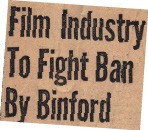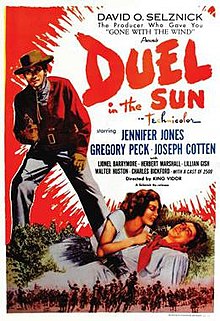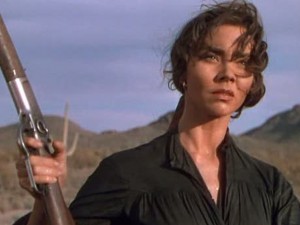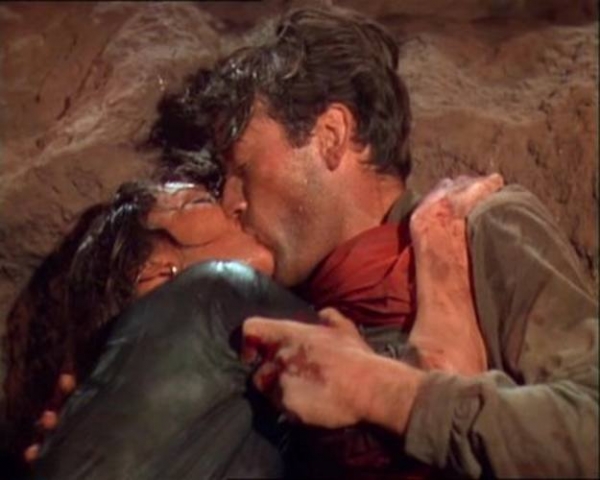Sorry, boys,” said the old man, squinting through his wire-rimmed glasses as the reels on the movie projector spun to a halt and somebody switched on the lights. “But I can’t let you show a film like that in Memphis.”
The movie he previewed was a 1947 Hal Roach comedy called Curley, and it showed black children and white children attending school together. That was all it took for the old man to declare it “inimical to the morals and welfare of our city,” as he would explain later. He also disliked any films starring Charlie Chaplin (“a London guttersnipe”), Ingrid Bergman (“because she was living in open and notorious adultery”), and the 1955 classic Rebel Without a Cause (“it promoted juvenile delinquency”).
And it certainly mattered what the old man liked and disliked, because from 1928 to 1955, he absolutely ruled the Memphis Censor Board. Memphians never saw many films shown in other cities, or they saw shortened versions of them because “offensive” scenes were snipped out. His harsh judgments of seemingly harmless films made him a household name across the nation, and Memphians still talk about the days when everything they could see, hear, or read was decided by Lloyd T. Binford.
King of Court Square
Binford was born in 1868 in the tiny hamlet of Duck Hill, Mississippi. His formal education ended after the fifth grade, but the boy had a keen eye for business. One July, he bought up the town’s complete stock of fireworks, then resold them to his pals for a handsome profit. A few years later, he opened up an outdoor roller-skating rink in Duck Hill and gave away square pencils as promotions, reasoning that customers would remember him if he gave them unusual gifts. This was at the age of 14, by the way.
When he was 16, Binford signed up as a railway clerk with the Illinois Central Railroad. It might have been a boring job for anyone else, but Binford’s first train smashed head-on into another, killing most of the crew and badly scalding him with steam. When he resumed work, his train was held up at gunpoint, and one of the robbers shot his fellow clerk through the heart.
Perhaps trying to find a safer occupation, Binford joined the staff of the Woodmen of the World, a fraternal organization offering insurance programs to its members. Working out of a tumbledown log cabin in Duck Hill, he soon began to organize other Woodmen units throughout Mississippi. It wasn’t long before another agency — the Columbia Mutual Life Insurance Company — noticed the young man and offered him a job. He quickly moved up the corporate ladder at Columbia, becoming president of the firm in 1916.
Though based in Atlanta, Binford wanted a more central location for his headquarters. He moved to Memphis and in 1925 began construction of the Columbia Mutual Tower, the 22-story, gleaming-white terra-cotta building (known today as the Lincoln America Tower) that still anchors one corner of Court Square. It was the tallest and grandest skyscraper in Memphis, and Binford’s office was on the top floor.
Getting “Binfordized”
Binford had come a long way from the log cabin in Duck Hill. His insurance business made him a millionaire, and he was named a colonel on the staffs of the governors of Mississippi and Tennessee. He became director of the Mid-South Fair, then chairman of the committee that was erecting the Shrine Building downtown. He was a Shriner, a Knight Templar, an Elk, a Rotarian, and a Kiwanian.
 Photos Courtesy Special Collections, University of Memphis Libraries
Photos Courtesy Special Collections, University of Memphis Libraries
Lloyd T. Binford
But nobody was quite sure why Binford, of all people, was named to head the newly formed Memphis Censor Board. His education (or lack of it) and his insurance background hardly qualified him to be the arbiter of public taste. That didn’t matter, though, because Memphis political boss E.H. Crump decided Binford was the man for the job. Binford himself always claimed he didn’t know he had even been chosen until he read the announcement in the newspapers. If that’s true, it was probably the last time something ran in the newspapers that he didn’t know about. The job paid him $200 a month, and Binford proudly wore a tiny badge that opened doors for him at movie theaters across the city and at screening rooms on Film Row downtown.
The Memphis Censor Board had been formed in 1921 to “censor, supervise, regulate, or prohibit any entertainment of immoral, lewd, or lascivious character, as well as performances inimical to the public safety, health, morals, or welfare.” Such broad powers would have shut down most of the theaters in the city, but the censor board rarely flexed its muscles.
Then Binford took over. And although the board had a half dozen other members, it was Binford’s verdict that counted.
Because of his own traumatic experiences with the railroad, Binford ruled against any films that included a train robbery. In 1940 alone, Memphians never saw Tyrone Power in Jesse James, Henry Fonda in The Return of Frank James, or Jane Russell in The Outlaw. As Binford repeatedly preached, such films were “inimical to the public welfare.”
That was just the start. Perhaps because the comedian Charlie Chaplin had a penchant for underage girls, Binford called him a “London guttersnipe” and “a traitor to the Christian-American way of life.” Why, he was even “an enemy of decency and virtue.” Binford banned all of Chaplin’s films in Memphis.
He also banned any films starring Ingrid Bergman because she left her husband and moved in with Italian director Roberto Rossellini. When announcing the ban on Bergman’s 1949 Stromboli, he refused to permit “the public exhibition of a motion picture starring a woman who is universally known to be living in open and notorious adultery.”
Movies banned by Binford were said to be “Binfordized,” and there were many of them. He killed the 1928 showing of Cecil B. DeMille’s King of Kings because the film story of Jesus differed slightly from the Bible, and he thought the crucifixion scenes were too violent. He banned The Woman They Almost Lynched (1953) simply because “I’m against pictures featuring Jesse James.” And Memphians couldn’t see Marlon Brando in the 1954 classic The Wild One because Binford considered it “rowdy, unlawful, and raw.”

Others getting a thumbs-down, sometimes for inexplicable reasons, included Dead End (1937) with Humphrey Bogart, Lost Boundaries (1949) with Mel Ferrer, Duel in the Sun (1946) starring Gregory Peck, The French Line (1953) with Jane Russell … the list goes on.
Even stage plays were halted. Binford dropped the curtain on an Ellis Auditorium production of Erskine Caldwell’s drama Tragic Ground because he found it “vulgar.”
In Murry Schumach’s 1964 book, The Face on the Cutting Room Floor, Hollywood producer Jerry Wald noted, “The censors of Memphis, Tennessee, have banned more Hollywood films than censors in any other city in the world.” Their efforts were sometimes futile, though, because theaters in Mississippi and Arkansas often ran the same films, promoting them as being “Banned in Memphis.” When, in one of his first actions as censor, Binford nixed Gloria Swanson’s Miss Sadie Thompson (1928), newspapers reported that 15,000 Memphians crossed the river to see it playing in West Memphis.
Publications such as Collier’s magazine, Variety, and The New York Times denounced Binford and ridiculed Memphis for giving him so much power. Time magazine spotlighted the censor in an August 13, 1945, article, calling him “dour and dogmatic” and observing that “Binford has long prided himself on being able to spot a suggestive line even before it is suggested.” When Binford banned the highly acclaimed 1945 movie The Southerners because he felt it gave a negative portrayal of the South, Time sneered, “Binford must have been sniffing too many magnolias.”
Scenes in Black and White
But it was Binford’s attitude toward blacks that caused him — and Memphis — the most condemnation. Binford was absolutely opposed to movies showing blacks and whites together on the same social level. In 1945, he blocked the hit musical Annie Get Your Gun from Ellis Auditorium because there were blacks in the cast “who had too familiar an air about them.” For the same reason, he banned the film Imitation of Life (1934) with Claudette Colbert and Brewster’s Millions (1945) with Eddie “Rochester” Anderson because certain scenes “gave too much prominence to Negroes.”

To show the films in Memphis, local distributors had to delete these scenes. As a result, some movies shown here were minutes shorter than the same films shown in other cities, because Binford ordered the complete removal of scenes featuring prominent black performers like Duke Ellington or Cab Calloway. Memphians probably never realized that Lena Horne’s segment, for example, was snipped completely out of the 1946 picture Ziegfield Follies, as was Pearl Bailey’s role in the 1947 Variety Girl.
In 1947, Binford axed Curley, a Little Rascals-type comedy distributed by United Artists, simply because it included one scene that showed black and white children in a classroom together. In his official letter to the United Artists distributors, Binford explained, “The Memphis Censor Board … is unable to approve your picture with the little Negroes, as the South does not permit Negroes in white schools nor recognize social equality between the races, even in children.”
United Artists found this explanation outrageous and took the case to the Tennessee Supreme Court. In a curious twist, the court actually upheld Binford’s ban on Curley but ruled that he could not ban future performances just because they included blacks. Binford grumbled, “Well, we’ll just have to pass those pictures now.”
Despite all this, Binford always insisted he was not a racist. “I’m one of the few white men in Memphis that actually got a six-pound fruitcake from Negro friends last Christmas,” he bragged in a Memphis Press-Scimitar interview. “And I also received 18 Christmas cards from colored folks — the same number that I sent out.”
In a 1950 interview with Collier’s, he actually claimed, “I cry, because I love old niggers.”
the “Depraved Element”
This being Memphis, not everyone disagreed with him. Binford liked to remind critics that, at one count, he had 141 children named after him or his wife, Hattie. He kept card files, so he could send all of “his” children Christmas presents. The boys usually got fountain pens. The girls — silk stockings.
Some Memphians even thought the censor wasn’t tough enough. A Commercial Appeal writer, apparently disturbed by the “rash of sex pictures” in 1937, demanded, “How long can this tolerant attitude continue if we are to have gutterstuff smeared across our screens? What kind of censor board is it that will sit back and permit public theaters to turn themselves into veritable cesspools for the evil satisfaction of the depraved element?”
Binford himself never thought he was a particularly harsh censor. In a newspaper interview the year he retired, he said, “We just try to do what the public wants, and the public is getting more liberal all the time.” Besides, he insisted, “I have no puritanical ideas of my own to put over.”
Ill health forced Binford to resign half a dozen times in later years, but his supporters always persuaded him to stay on. Eventually, his arthritis got so bad that he had to climb the stairs backward to reach the second-floor office of his home on Peabody. He was finally allowed to step down as head of the censor board on January 1, 1956. He died the following year, at the age of 89, and is buried in Elmwood Cemetery.
After his death, Binford was eulogized in The Commercial Appeal as a man whose “useful endeavors … helped make this city and section prosperous and substantial in every respect.”
Six years later, however, author William Faulkner paid a different sort of tribute to Binford. In The Reivers, published in 1962, he created a character described as “a man of style and presence and manner and ideals; incorruptible in principles, impeccable in morals.” The character’s name was none other than Mr. Binford. And in The Reivers, he ran a whorehouse in Memphis.



 Photos Courtesy Special Collections, University of Memphis Libraries
Photos Courtesy Special Collections, University of Memphis Libraries 
